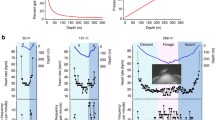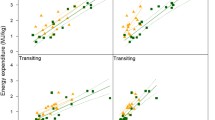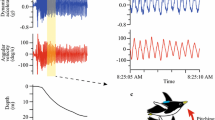Abstract
Using a turtle-borne camera system, changing flipper beat frequency and amplitude were measured in five diving green turtles (Chelonia mydas Linnaeus 1758) in the Bahía de los Angeles, Mexico (28°58′N, 113°33′W). These observations were made between June and August 2002. Turtles worked hardest (i.e., had the highest flipper beat frequency and amplitude) at the start of descents when positive buoyancy is predicted to oppose their forward motion. During the later part of descents, turtles worked less hard in line with opposing buoyancy forces being reduced. For example, flipper beat frequency declined from about 60–80 beats min−1 at the start of descent to around 25–40 beats min−1 after 30 s of the descent. At the start of ascents the flipper beat frequency was around 30 beats min−1, lower than on descent, and declined as the ascent progressed with often passive gliding for the final few meters to the surface. This pattern of effort during diving appears to apply across a range of marine reptiles, birds and mammals suggesting that graded effort during descent and ascent is an optimum solution to minimising the cost of transport during diving.





Similar content being viewed by others
References
Hays GC, Metcalfe JD, Walne AW (2004a) The implications of lung regulated buoyancy control for dive depth and duration. Ecology 85:1137–1145
Hays GC, Metcalfe JD, Walne AW, Wilson RP (2004b) First records of flipper beat frequency during sea turtle diving. J Exp Mar Biol Ecol 303:243–260
Hochscheid S, Bentivegna F, Speakman JR (2003) The dual function of the lung in chelonian sea turtles: buoyancy control and oxygen storage. J Exp Mar Biol Ecol 297:123–140
Hochscheid S, Bentivegna F, Hays GC (2005) First records of dive durations for a hibernating sea turtle. Biol Lett 1:82–86
Hooker SK, Miller PJO, Johnson MP, Cox OP, Boyd IL (2005) Ascent exhalations of Antarctic fur seals: a behavioural adaptation for breath-hold diving? Proc Roy Soc B 272:355–363
Lovvorn JR, Croll DA, Liggins GA (1999) Mechanical versus physiological determinants of swimming speeds in diving Brunnich’s guillemots. J Exp Biol 202:1741–1752
Lovvorn JR, Watanuki Y, Kato A, Naito Y, Liggins GA (2004) Stroke patterns and regulation of swim speed and energy cost in free-ranging Brünnich’s guillemots. J Exp Biol 207:4679–4695
Lutz PL, Bentley TB (1985) Respiratory physiology of diving in the sea turtle. Copeia 1985:671–679
Miller PJO, Johnson MP, Tyack PL, Terray EA (2004) Swimming gaits, passive drag and buoyancy of diving sperm whales Physeter macrocephalus. J Exp Biol 207:1953–1967
Marshall GJ (1998) CRITTERCAM: an animal-borne imaging and data logging system. Mar Tech Soc J 32:11–17
Reina RD, Abernathy KJ, Marshall GJ, Spotila JR (2005) Respiratory frequency, dive behaviour and social interactions of leatherback turtles, Dermochelys coriacea during the inter-nesting interval.J Exp Mar Biol Ecol 316:1–16
Sato K, Mitani Y, Cameron MF, Siniff DB, Naito Y (2003) Factors affecting stroking patterns and body angle in diving Weddell seals under natural conditions. J Exp Biol 206:1461–1470
Seminoff JA, Jones TT, Resendiz A, Nichols WJ, Chaloupka MY (2003) Monitoring green turtles (Chelonia mydas) at a coastal foraging area in Baja California, Mexico: multiple indices to describe population status. J Mar Biol Assoc UK 83:1355–1362
Skrovan RC, Williams TM, Berry PS, Moore PW, Davis RW (1999) The diving physiology of bottlenose dolphins (Tursiops truncates)—II. Biomechanics and changes in buoyancy at depth. J Exp Biol 202:2749–2761
Southwood AL, Andrews RD, Paladino FV, Jones DR (2005) Effects of diving and swimming behavior on body temperatures of Pacific leatherback turtles in tropical seas. Phys Biochem Zool 78:285–297
van Dam RP, Ponganis PJ, Ponganis KV, Levenson DH, Marshall G (2002) Stroke frequencies of emperor penguins diving under sea ice. J Exp Biol 205:3769–3774
Wallace BP, Williams CL, Paladino FV, Morreale SJ, Lindstrom RT, Spotila JR (2005) Bioenergetics and diving activity of internesting leatherback turtles Dermochelys coriacea at Parque Nacional Marino Las Baulas, Costa Rica. J Exp Biol 208:3873–3884
Watanuki Y, Niizuma Y, Gabrielsen GW, Sato K, Naito Y (2003) Stroke and glide of wing-propelled divers: deep diving seabirds adjust surge frequency to buoyancy change with depth. Proc R Soc Lond B 270:483–488
Williams TM, Davis RW, Fuiman LA, Francis J, Le Boeuf BJ, Horning M, Calambokidis J, Croll DA. (2000) Sink or swim: strategies for cost-efficient diving by marine mammals. Science 288:133–136
Wilson RP, Liebsch N (2003) Up-beat motion in swinging limbs; free-living aquatic vertebrates. Mar Biol 142:537–547
Wilson RP, Culik BM, Peters G, Bannasch R (1996) Diving behaviour of Gentoo penguins, Pygoscelis papua; factors keeping dive profiles in shape. Mar Biol 126:153–162
Wilson RP, Hustler K, Ryan PG, Burger AE, Noldeke EC (1992) Diving birds in cold water—do Archimedes and Boyle determine energetic costs? Am Nat 140:179–200
Wilson RP, Locca R, Scolaro JA, Laurenti S, Upton J, Gallelli H, Frere E, Gandini P (2001) Magellanic penguins Spheniscus magellanicus commuting through San Julian Bay; do current trends induce tidal tactics? J Avian Biol 32:83–89
Acknowledgments
We would like to thank the following individuals for their field assistance: Marcos Blanco, Fernando Clemente, Steve Collins, Jennifer Gilmore, Anthony Lusk, Alexa McDermott, Antonio Resendiz, Travis Smith, and Lucy Yarnell. Special thanks go to Kira Fuchs, Scott Snider, Lynne Barre and the National Geographic Special Projects team for providing technical assistance with Crittercam throughout this project. This work was supported by Earthwatch Institute, National Geographic Special Projects, Wallace Research Foundation and the Natural Environment Research Council of the UK (NERC). Research was authorized by the Secretaría de Medio Ambiente, Recursos Naturales, y Pesca (Permit numbers 150496-213-03, 280597-213-03, 190698-213-03, 280499-213-03) and the Secretaría de Medio Ambiente y Recursos Naturales (Permit # SGPA/DGVS/002). We thank two anonymous referees for their comments which greatly improved the final manuscript.
Author information
Authors and Affiliations
Corresponding author
Additional information
Communicated by J.P. Grassle, New Brunswick
Rights and permissions
About this article
Cite this article
Hays, G.C., Marshall, G.J. & Seminoff, J.A. Flipper beat frequency and amplitude changes in diving green turtles, Chelonia mydas . Mar Biol 150, 1003–1009 (2007). https://doi.org/10.1007/s00227-006-0412-3
Received:
Accepted:
Published:
Issue Date:
DOI: https://doi.org/10.1007/s00227-006-0412-3




